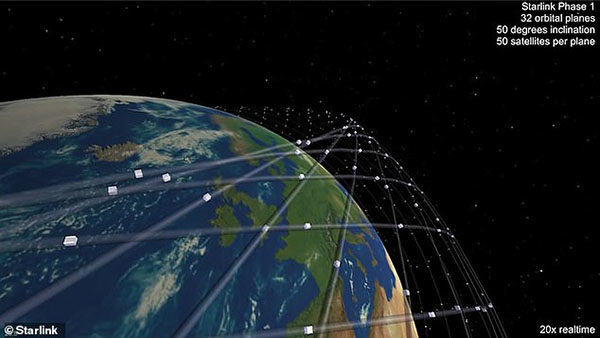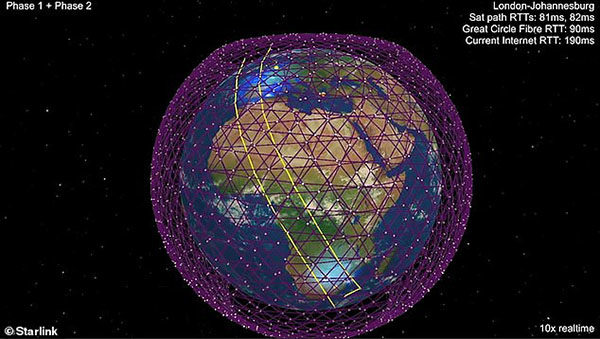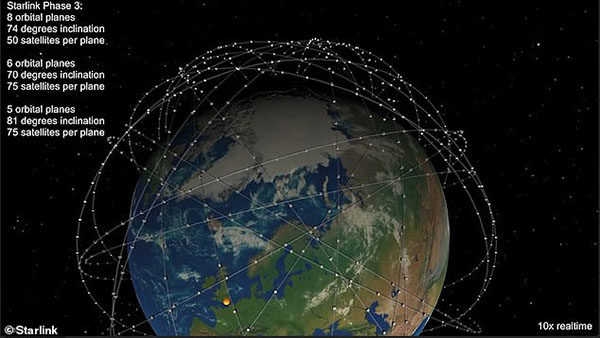Elon Musk’s plan for a global internet powered by thousands of satellites edges closer to reality as the US government approves 7,518 MORE ‘Starlink’ spacecraft
- Starlink previously had approval from the FCC for 4,425 specialist satellites
- Has now been granted approval for an 7,518 more that will orbit closer to Earth
- Starlink is designed to bring internet to the entire world and potentially Mars
Elon Musk’s plan to provide a global internet via an enormous network of orbiting satellites is one step closer to reality.
The Federal Communications Commission (FCC) has approved plans from the billionaire entrepreneur to deploy 7,518 additional broadband satellites for the Skylink project.
This takes the total number of possible satellites for the ambitious plan of the SpaceX founder up to 11,943.
SpaceX’s Starlink broadband service will use these additional satellites in a close-Earth orbit to ‘boost capacity and reduce latency in heavily populated areas’.
SpaceX intends to eventually develop the infrastructure of Skylink and deploy it on colonized planets, such as Mars.
The proposal was unanimously accepted by the US body and they said in a draft that the satellites would operate on frequencies between 37.5 and 42GHz to communicate between space and Earth.
‘After review of the record, we conclude that granting of the SpaceX application will serve the public interest,’ the FCC said.
Full acceptance is still dependent upon Starlink meeting strict criteria pertaining to power consumption, potential interference with other stems and minimising space junk.
Each satellite in SpaceX’s planned group will weigh about 850 lbs (386 kg).
The original 4,425 satellites will orbit at altitudes ranging from 715 miles (1,150 km) to 790 miles (1,275 km).
From this height each satellite will be able to cover an area on the ground about around 1,300 miles (2,120 km) wide.
Musk has also claimed that SpaceX’s broadband network will have latencies of only 25ms at this distance
Starlink’s latest batch of satellites would orbit even closer to Earth at altitudes of between 208 miles and 215 miles (335km and 346km).
The project, which Musk previously said would cost at least $10 billion (£8.03 billion), was first announced in January 2015.
Professor Mark Handley from University College London devised a detailed clip of how the SpaceX project will likely operate.
The seven-minute footage shows 32 different orbital planes with 50 satellites rotating on each.

Detailed: Professor Mark Handley from University College London has devised a detailed clip of how the SpaceX project will probably operate in the solar system

Visualisation: The seven-minute footage, which will be presented at a conference next week, shows 32 different orbital planes with 50 satellites rotating on each
It illustrates the most likely way they’ll be be positioned – and how they’ll interact with one another to avoid collisions.
Mr Handley based his visualisation on information from Musk’s public documents to the US Federal Communications Commission.
‘I wanted to understand what it might mean for the future of the Internet, and whether it would work well enough to pay for itself,’ Mr Handley told MailOnline.
‘To do this, I wrote a computer simulation based one what is in public filings, and filled in the rest from basic physics and my knowledge of networking.
‘If they can build it, and I think they probably can, then it promises to revolutionise the Internet, giving good connectivity anywhere on Earth.’
The video also suggests there’ll be a density of satellites over London, Paris, New York and Frankfurt at latitudes between 47 and 52 degrees.

Expensive ambitions: The SpaceX project, which Musk previously said would cost at least $10 billion (£8.03 billion), was first announced in January 2015 and launched satellites in February

Realistic: Mr Handley based his visualisation on information from Musk’s public documents to the US Federal Communications Commission, who previously approved the project
This, Mr Handley adds, is because it’s likely to serve financiers foremost.
‘The real question though is who will pay for it? What the simulations show is that this network can signicantly cut the communications delay for long distance traffic,’ he said.
‘That’s nice for video conferencing and gaming, but it’s crucial for the finance industry. In that business, if you know something a few milliseconds before anyone else, you can make money.
‘So I think that this network will be paid for by the finance industry, who probably won’t have a choice whether to use it – if they don’t, they’ll lose money to the companies that do.
‘And on the back of that, it will suddenly become cost effective to do things like putting solar powered cell towers that connect via Starlink in the middle of remote parts of Africa, enabling them to gain access to information the rest of us take for granted.’
WHAT IS STARLINK AND WHAT ARE ITS GOALS?
Elon Musk’s SpaceX has launched the first two of its ‘Starlink’ space internet satellites.
They are the first in a constellation of thousands of satellites, designed to provide low-cost broadband internet service from low Earth orbit.
The constellation, informally known as Starlink, and under development at SpaceX’s facilities in Redmond, Washington.
Its goal is to beam superfast internet into your home from space.
While satellite internet has been around for a while, it has suffered from high latency and unreliable connections.
Starlink is different. SpaceX says putting a ‘constellation’ of satellites in low earth orbit would provide high-speed, cable-like internet all over the world.
The billionaire’s company wants to create the global system to help it generate more cash.
Musk has previously said the venture could give three billion people who currently do not have access to the internet a cheap way of getting online.
It could also help fund a future city on Mars.
Helping humanity reach the red planet is one of Musk’s long-stated aims and was what inspired him to start SpaceX.
The company recently filed plans with the Federal Communications Commission (FCC) to launch 4,425 satellites into orbit above the Earth – three times as many that are currently in operation.
‘Once fully deployed, the SpaceX system will pass over virtually all parts of the Earth’s surface and therefore, in principle, have the ability to provide ubiquitous global service,’ the firm said.
‘Every point on the Earth’s surface will see, at all times, a SpaceX satellite.’
The network will provide internet access to the US and the rest of the world, it added.
It is expected to take more than five years and $9.8 billion (£7.1bn) of investment, although satellite internet has proved an expensive market in the past and analysts expect the final bill will be higher.
Musk compared the project to ‘rebuilding the internet in space’, as it would reduce reliance on the existing network of undersea fibre-optic cables which criss-cross the planet.
In the US, the FCC welcomed the scheme as a way to provide internet connections to more people.








No Comments